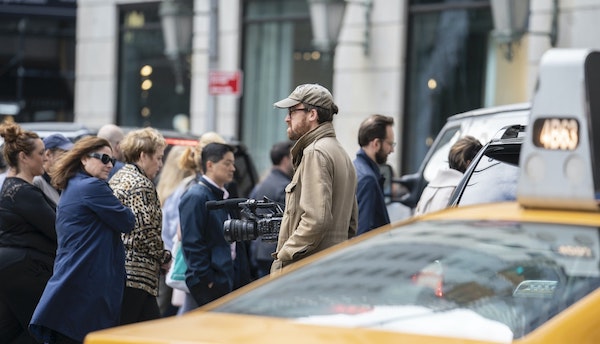Television Review: “How To with John Wilson” — Fascinating Adventures on the Fly
By Sarah Osman
In this brilliant series, documentary filmmaker John Wilson captures the absurdity of life in New York.

Filmmaker John Wilson in a scene from HBO’s How To with John Wilson.
Nathan for You was one of the most bizarre yet engrossing comedies to ever air on television. Starring Nathan Fielder, who “graduated from one of Canada’s top business schools with really good grades,” the series followed Fielder as he attempted to help small businesses. His ideas were zany, ranging from suggesting that a frozen yogurt shop sell poop flavored fro-yo to embarking on an epic trip to help an old man reunite with his long lost love. Nathan for You was cringeworthy, hilarious, and at times oddly poignant — the series often had more to say about the human condition and life in Los Angeles than most serious dramas.
It’s not surprising that How To with John Wilson, which is executive produced by Fielder, has a similarly eccentric vision. The series, which airs Fridays on HBO, follows documentary filmmaker John Wilson as he captures the absurdity of life in New York. Each episode focuses on a single theme, such as “How to put up Scaffolding” to “How to Cover Your Furniture.” Wilson tries to remain focused on the single task but, as he meets more people along the way, the episodes veer off into funny as well as unexpected directions. Much of the show’s magic comes from the zigs and zags of serendipity: what starts off as a simple project, such as how to have small talk, shifts into Wilson sitting with a so-called “child predator capturer,” who educates Wilson on how exactly he goes about his job. This interaction leads Wilson to Spring Break in Cancun, where he struggles to fit in with the partiers. He eventually finds solace with a fellow introvert who came to Spring Break to find love. As the series goes on, Wilson finds himself popping up in other unforeseen situations, such as a Mandela Effect Conference and with a man naked from the waist down (I don’t want to reveal the surprise of that confab).
While many of these encounters are amusing because of how bizarre they are, each meeting eventually generates serious questions about society. The Mandela Effect conference episode interrogates the ambiguous nature of memory and why we choose to remember what we do; a piece on scaffolding muses on how it can serve as a metaphor for things that, at first intended to be temporary, grow to be a vital part of our lives (ironically, we are now facing this with Covid). None of these issues are explicitly stated, nor does Wilson ever attempt to recap what he has learned. His “lessons” are delivered in a perfectly neutral tone, which only makes them funnier — and more powerful.
Ironically, we very rarely see Wilson (sans shots of his feet and hands). How To … is presented entirely from Wilson’s point of view, which is in direct contrast with Nathan for You, where we saw Nathan and how he interacted with those around him (whether they were angry or unsure how to handle him). We never see Wilson’s expressions; his subjects seem rather happy to talk right to the camera. In this sense, Wilson is not the series’ protagonist. He is more of a sounding board whose musings and discoveries are made all the more interesting because they come from such a detached place.
While How To… ventures outside of New York, most of the series was filmed pre-Covid. It’s more than a little jarring to compare a city so vibrant (and delightfully strange) to the New York of today. I would love to see Wilson film an episode in Los Angeles, my hometown, or Boston, but he seems to have an intuitive symbiosis with the Big Apple. Wilson’s shots of New York really do capture what makes it …well, New York. The result is a show that you don’t want to look away from. I have the habit of writing while I watch TV, but How To with John Wilson demanded my full attention. There are so many quicksilver cutaway shots, each one more brilliant than the last.
How To with John Wilson‘s season finale was a complete triumph, somehow bringing together all the odd segues and subjects while reminding us of how fleeting our lives can be, the indispensability of each moment. The entire series came together in the end. Here’s hoping that it was a respite rather than a termination. Wilson richly deserves a shot at a second season – there are so many other adventures worth taking on the fly.
Sarah Mina Osman is a writer living in Los Angeles. She has written for Young Hollywood and High Voltage Magazine. She will be featured in the upcoming anthology Fury: Women’s Lived Experiences under the Trump Era.
